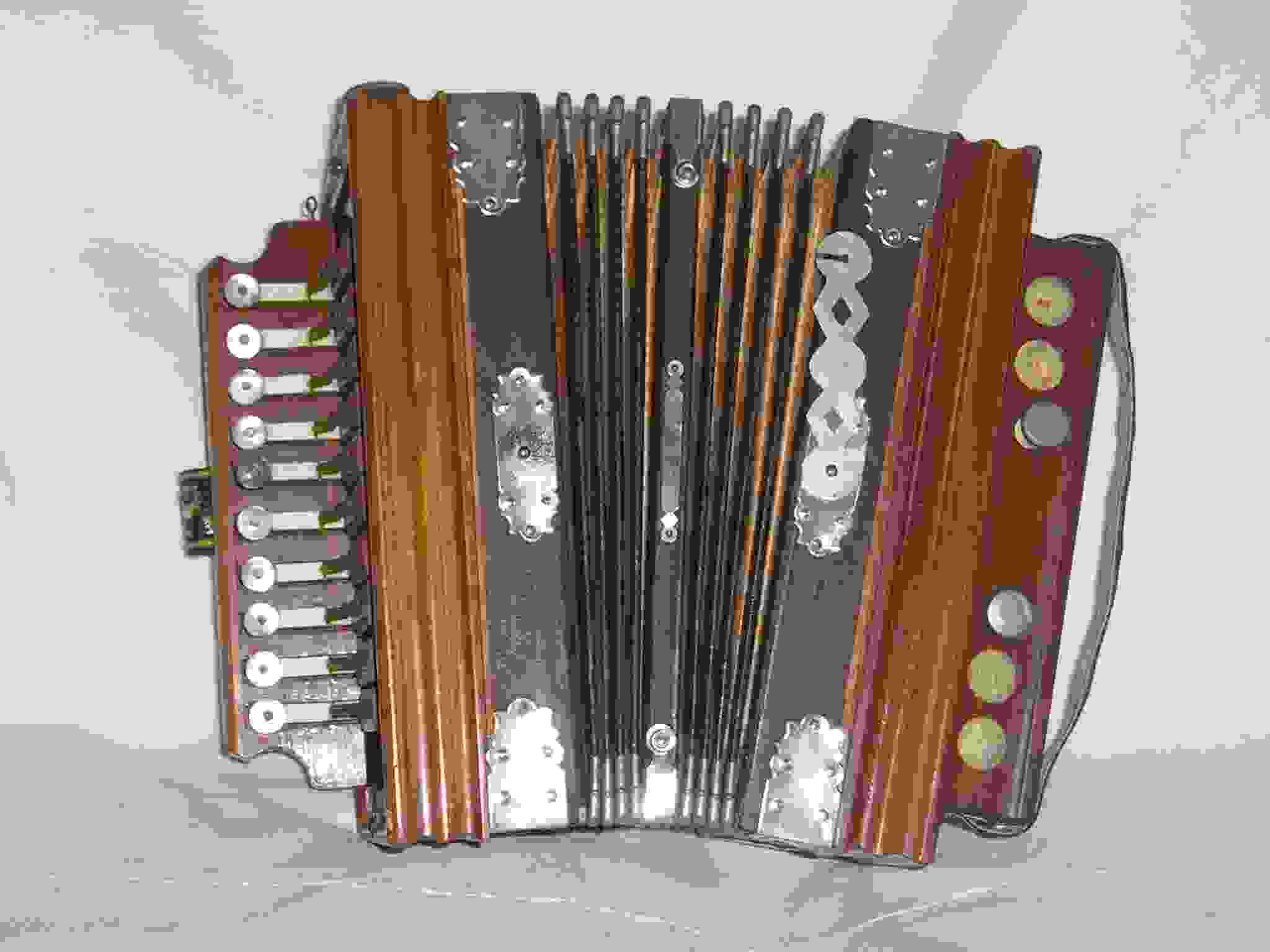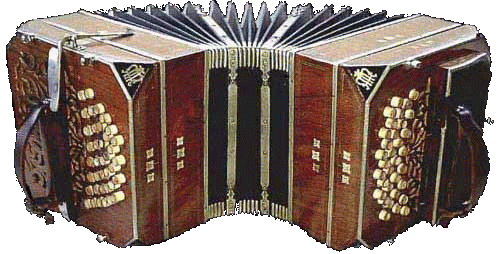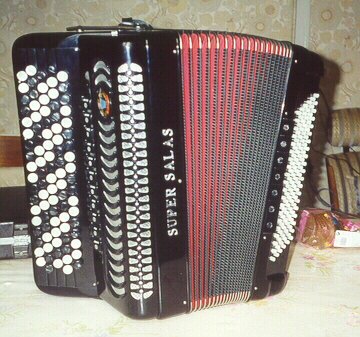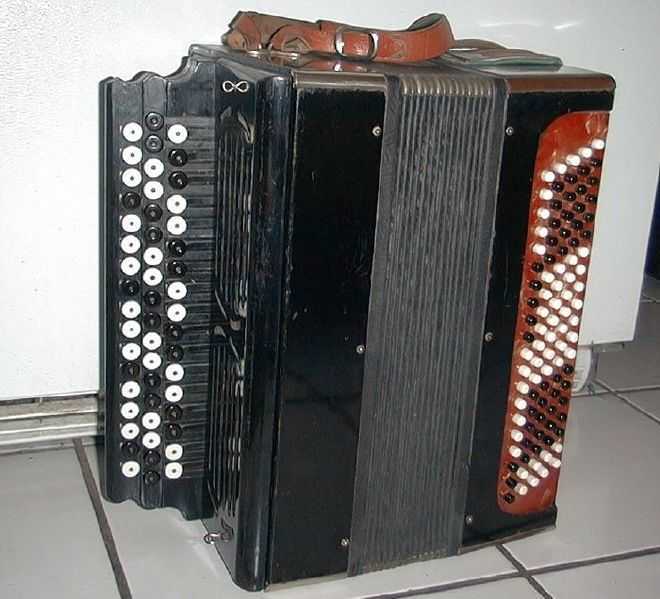THE
ACCORDIONS
TYPES
THE DIATONIC ACCORDION
Since 1830, the diatonic accordion is the instrument of the popular festivals and the folk musics which invites to sing and dance. It is a wind instrument with metal free reeds. The ventilation is provided by bellows which is activated in alternation (pushed, pulled). The notes are activated by buttons. Initially with only one line of buttons for the song (called "melodeon" in Germany and "du botte" in Italy), it becomes a more sophisticated instrument about 1880. This easy to handle accordion has an organization close to the diatonic harmonica that is to say organized depending on one or several diatonic scales. Following a logic called bi-sound: we do not obtain the same sound if we push or if we pull the bellows, but these two nuances, bi-sound and diatonic, are merged most of the time. In general, this instrument of rustic appearance is composed of two keyboards (song and bass keyboard accompaniment). The song keyboard is composed of about 20 butttons on 2 to 3 lines of buttons and up to 18 buttons on the bass keyboard of accompaniment (bass and cords). It has an extent of approximately 2 to 3 octaves on the song keyboard. Its functioning is restricted to 2 or 3 tonalities (for example: G-C for a 2 lines, G-C-F for a 3 lines).



THE CONCERTINA
The concertina, patented in 1844, belongs to a class of instruments known as Free Reed instruments, which also includes accordions and harmonicas. It was developed by Sir Charles Wheatstone after several years of building prototypes, a few of which still exist (in 1829 he patented its direct predecessor, the Symphonium, but he did not actually patent the concertina itself until 1844). He founded the firm of Wheatstone & Co to manufacture concertinas, each one expensively hand-made by highly skilled craftsmen, and at first the concertina was very much an instrument of the middle and upper class drawing room. Its fully chromatic range was suited to classical pieces. In due course other firms such as Lachenal and Jeffries were founded (several by ex-Wheatstone employees) the cost of concertinas lowered, and the instrument moved out of the drawing room and into the world of popular music.

THE BANDONION
The bandonion is a musical instrument of the family of the free reeds instruments. It can be diatonic or chromatic. After the invention of the accordion by Cyrill Demian and inspired by the concertina invented by the English Charles Weathstone in 1844, the German Heinrich Band (1821-1860) decided that this instrument had to accompany the processions in Germany. It is only thanks to immigration towards South America that he discovers other musics in Argentina. There, it will become the instrument of the tango and we forget its origins.

![]()
THE CHROMATIC ACCORDION
Contrary to the diatonic accordion, a key produces the same note by pulling
or by pushing the bellows. The right hand generally plays the melody but
also allows to accompany other soloists' instruments . The right hand
keyboards exist in a version with piano keys and in a version with button
keys. The left hand plays the accompaniment. The left han keyboard is
composed of fundamental basses and precomposed chords.
To the accordion of accompaniment of the dances and songs, to the family
instrument, the chromatic accordion is a technically advanced instrument
which imposes its complete panoply of sounds, which will lead it to the
hands of the experts, towards the scenes of concert. Considered as the
accordion "of the tradition", it develops with the vogue for the musette
balls which sweeps through France. It is also very used in Jazz.


![]()
THE HARMONÉON or ACCORDION IN CONCERT
Initially named "Harmonéon" by its designer Pierre Monichon in 1956, it becomes "accordion in concert". This terminology was wanted by the UPAC (Union for the Promotion of the Accordion), in order to democratize and to promote the instrument. Pierre Monichon wanted to make this instrument an instrument in concert as the piano or the violin. Technically speaking, the accordion in concert includes 2 similar keyboards, with identical places for the bass and deep and high sounds, and the same position of the buttons. The buttons linked to the chords are removed. On this accordion model, there are no song keyboard and accompaniment keyboard any more. Thus released of these precomposed chords, the accordion in concert is musicaly entirely free. We can note that the accordion in concert, in the spirit, looks like its Argentinian cousin the bandonion which has also two identical keyboards which allows it to go in ball, but also in concert without having to change the instrument.

THE BAYAN
It is the name of the chromatic accordion in Russia. There are 2 systems: the Russian system (Eastern) called B-system recognizable by the colour of the buttons of the first line with the succession of three black and a white and the C-system (Western) with the succession of two black and two white. Here you can see two types of Russian accordions Bayan : the first with a B-system keyboard used in Russia, the second with a C-system used in France.

